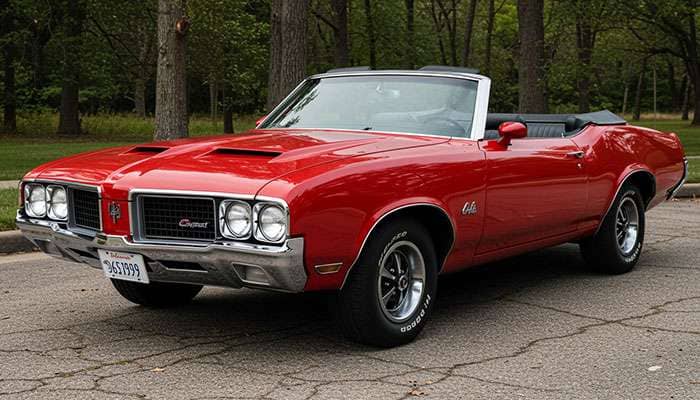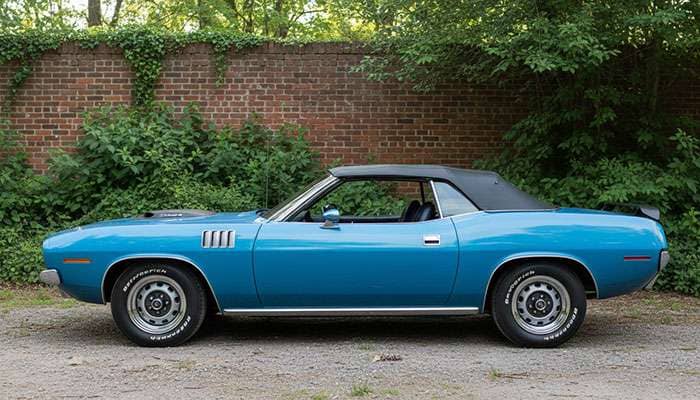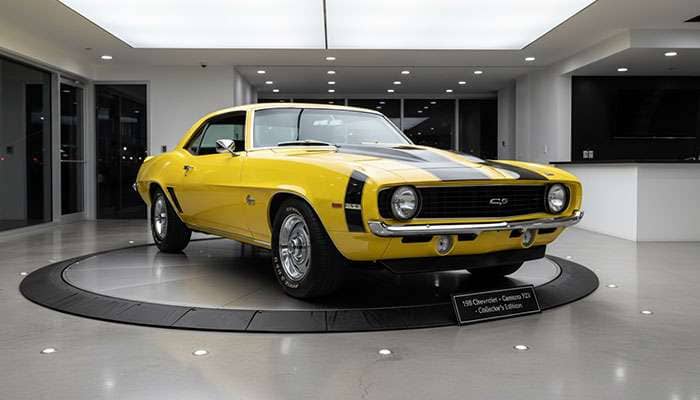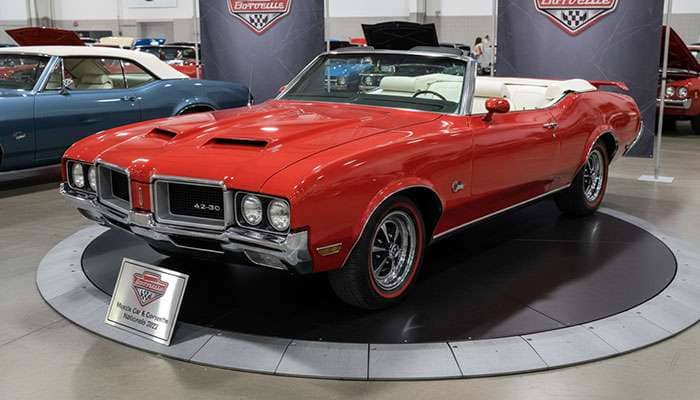
The 1971 Plymouth Hemi 'Cuda Convertible reigns supreme as the undisputed holy grail of muscle cars. Only 12 units rolled off the production line for that model year, with just 7 making it to American buyers. This incredible scarcity has pushed auction prices into the stratosphere—examples routinely sell for $3 to $5 million, including one Bright Blue example that hammered at $3.5 million in 2014.
Collectors and enthusiasts have crowned the '71 Hemi 'Cuda Convertible the "Holy Grail of Muscle Cars" for good reason. The combination of microscopic production numbers and earth-shaking performance creates the perfect storm of desirability. Consider the 1970 Oldsmobile 442 W-30 Convertible—only 96 were built with the high-performance W-30 package and 4-speed manual transmission. These factory-tuned beasts ripped through the quarter-mile in the high 13-second range at over 100 mph, straight from the showroom.
The stories behind these legendary machines reveal what drives collectors to pay millions for a slice of automotive history. We'll explore the elements that elevate certain muscle cars from merely rare to absolutely priceless.

When it comes to muscle cars, achieving "holy grail" status requires more than just age or good looks. These automotive legends possess a perfect combination of characteristics that separate them from ordinary classic cars. Understanding these factors helps explain why certain models command millions while others remain affordable.
Scarcity forms the foundation of holy grail appeal. These vehicles were produced in incredibly small numbers—often fewer than 100 units for the most desirable configurations. The rarest examples weren't just limited production models but specialized machines built for specific purposes:
Race homologation specials designed to qualify engines for NASCAR or drag racing
Prototype vehicles that never reached full production
Special-order combinations of engines and options rarely chosen by buyers
Limited editions created exclusively for testing new ideas
The 1969 Firebird Trans Am exemplifies this principle—every unit was finished in white with blue racing stripes, creating instant recognition. Similarly, the 1969 Chevrolet Camaro ZL1 achieved legendary status with only 69 units built through Chevrolet's special-order COPO program.
Rarity alone doesn't guarantee holy grail status. These cars deliver exceptional performance through innovative engineering. During the late 1960s and early 1970s, manufacturers waged what enthusiasts call the "horsepower wars," pushing automotive power to unprecedented levels.
These machines featured purpose-built engines like the 426 Hemi, which generated well over 425 horsepower. Many were deliberately underrated for insurance purposes, with actual output far exceeding advertised figures. The 1967 Corvette L88 was essentially a race car with license plates—it lacked basic amenities like heaters or radios to discourage casual buyers.
Ford's Thunderbolt represents this philosophy perfectly. Stripped of unnecessary weight and equipped with a 427 high-riser V8 engine, it was built specifically for drag racing dominance. These weren't just fast cars—they represented American engineering at its peak.
Holy grail muscle cars transcend mechanical specifications to become cultural icons. These machines emerged during a unique period when the economy thrived and gasoline was cheap. They starred in films like Bullitt and Vanishing Point, becoming symbols of American automotive culture.
Their timing was crucial. Most were built during a narrow window before the 1973 oil crisis and emissions regulations changed everything. These vehicles capture the spirit of an era that vanished overnight, making them rolling time capsules of automotive excess.
Perhaps most important is the condition and authenticity of surviving examples. Cars with documented originality and verifiable history command premium prices. The most valuable examples retain their "born with" components—original engines, transmissions, and body panels.
Expert validation establishes legitimacy. Authentication specialists like Steve Minore for Oldsmobiles or Galen Govier for Mopars can verify factory chalk marks, crayon markings, and paint dabs that separate genuine articles from replicas. The 1970 Oldsmobile 442 W-30 Convertible earned its "Holy Grail" designation through exceptional originality and ironclad documentation.
Original documentation—including build sheets, window stickers, broadcast cards, and protection plates—provides irrefutable proof of provenance. Collectors prize cars with known histories, previous owner records, and period photographs that establish an unbroken chain of custody.

The 1971 Plymouth Hemi 'Cuda Convertible stands as the final masterpiece of America's muscle car golden age. This rare classic muscle car has achieved legendary status among collectors worldwide, representing the last hurrah of an era when Detroit built cars without compromise.
Numbers tell the story of exclusivity. Plymouth built approximately 18,000 Barracudas in 1971, yet only 12 convertibles received the mighty Hemi engine. Seven stayed in the United States while five went overseas. Manual transmission versions are even rarer—sources vary between three and seven 4-speed examples ever built. One Winchester Gray example came with the A33 track-pak option, adding an ultra-rare Dana 60 Sure Grip rear axle to the mix.
The market speaks clearly about the '71 Hemi 'Cuda Convertible's value. A Bright Blue example with matching numbers hammered at $3.5 million at Mecum's Kissimmee auction in 2014. Since then, these ultra-rare convertibles consistently sell in the $3-5 million range. One sale in 2018 reached $3.3 million for a documented numbers-matching example.
These astronomical prices reflect the car's status as the last of its kind—after 1971, Chrysler discontinued the Hemi engine due to stricter emissions standards. The window of opportunity to own one of these factory Hemi convertibles closed permanently, cementing their place in automotive history.
The 1971 model marked the end of an era. Plymouth's E-body platform received updated styling with four headlights and a new grille, creating what many consider the most aggressive-looking Barracuda ever built. The 426 Hemi engine—conservatively rated at 425 horsepower but delivering far more—represented Chrysler's ultimate performance statement.
These weren't just powerful—they were purpose-built machines. The Hemi engine featured hemispherical combustion chambers that allowed larger valves and better breathing than competitors' engines. Combined with the Shaker hood scoop that protruded through the hood and moved with the engine, the '71 Hemi 'Cuda became an instant icon.

The 1967 Corvette L88 represents Chevrolet's race-bred performance taken to the streets. With only 20 examples built during its debut year, it stands among the rarest and most valuable Corvettes ever produced.
Chevrolet made the L88 intentionally difficult to order. The option cost $947.90 and came with mandatory deletion of radio, heater, and air conditioning. This deliberate inconvenience discouraged casual buyers, ensuring these performance machines went to serious racers rather than weekend warriors. The strategy worked—all 20 1967 L88s were ordered through special channels by racing teams and knowledgeable enthusiasts.
The L88's official rating of 430 horsepower told only part of the story. Chevrolet deliberately underrated the engine's actual output, which dyno tests later proved exceeded 550 horsepower in race trim. The 427 cubic-inch V8 featured an aluminum cylinder head design with open-chamber combustion, a radical solid-lifter camshaft, and a high-flow aluminum intake manifold.
The engine demanded 103-octane racing fuel—regular pump gas would destroy it through detonation. This requirement further separated serious racers from casual buyers. The L88 needed constant attention, making it fundamentally unsuitable for street use despite its road-legal status.
Everything about the L88 prioritized performance over comfort. The lack of radio and heater wasn't a cost-cutting measure—it was weight reduction. The suspension was brutally stiff, and the high-lift camshaft created a lumpy idle that shook the entire car. At speeds below 2,500 RPM, the engine barely ran smoothly.
Chevrolet intended these cars for tracks, not highways. Many L88 Corvettes competed successfully in SCCA racing, Trans-Am series, and endurance events like the 24 Hours of Daytona. Their racing pedigree drives collector values today—documented racing history can add hundreds of thousands to an L88's auction price.

The 1969 Camaro ZL1 rewrote the rules of muscle car performance. Built through Chevrolet's Central Office Production Order (COPO) system, it delivered factory drag racing capability that embarrassed purpose-built race cars.
Fred Gibb Chevrolet in La Harpe, Illinois made history by ordering all 69 ZL1 Camaros through the COPO system. The special order program allowed dealers to specify non-standard equipment combinations. Gibb recognized that the all-aluminum ZL1 engine—Chevrolet's ultimate racing powerplant—could be installed in a street-legal Camaro.
Production numbers stayed microscopic because each ZL1 carried a staggering $7,200 price tag in 1969—roughly equivalent to $60,000 today. This astronomical cost put ZL1s firmly in exotic car territory, pricing them beyond most enthusiasts' reach.
The ZL1's party trick was its all-aluminum big-block V8. While official ratings claimed 430 horsepower, the actual output exceeded 550 horsepower on racing fuel. More importantly, the aluminum construction saved approximately 100 pounds compared to iron-block engines. This weight reduction transformed the Camaro's handling and acceleration characteristics.
The engine featured open-chamber aluminum heads, a radical solid-lifter camshaft, and a Holley 850 CFM carburetor. Compression ratio of 12.0:1 demanded high-octane racing fuel. Like the L88 Corvette, these weren't engines for casual street driving—they required constant maintenance and expertise to run properly.
Performance numbers separated the ZL1 from pretenders. Straight from the dealer lot, properly tuned ZL1 Camaros ran high 11-second quarter-mile times. With racing slicks and minor tuning adjustments, they broke into the 10-second range. These numbers embarrassed dedicated drag cars and dominated Super Stock racing classes throughout 1969.
Dick Harrell, a legendary drag racer and tuner, purchased several ZL1s and used them to set numerous records. His "Mr. Stock Eliminator" ZL1 became famous for dominating NHRA Super Stock events. Today, ZL1s with documented racing history command premium prices at auction, with examples selling for $1-3 million depending on provenance and condition.

The 1970 Oldsmobile 442 W-30 Convertible stands as Detroit's masterpiece of engineering precision and raw muscle car power. This rare machine showcases what happens when factory engineers get serious about performance.
Oldsmobile's W-30 package delivered something special—genuine factory blueprinting through their "Select Fit" process. Engine builders carefully matched internal components by size and weight, creating engines that ran like precision instruments. The results spoke for themselves: W-30 442s consistently ripped through the quarter-mile in the high 13-second range at over 100 mph, straight from the dealer lot.
The W-30 package included a fiberglass hood with functional air scoops, aluminum intake manifold, special camshaft, and high-performance cylinder heads. The mighty 455 cubic-inch V8 was conservatively rated at 370 horsepower, but the W-30 modifications—including a low-restriction air cleaner and specially calibrated carburetor—unleashed the engine's true potential.
Production numbers tell the story of this car's rarity. Just 96 convertibles rolled off the line with the W-30 package and 4-speed manual transmission for the 1970 model year. Another 168 examples were built with the Turbo 400 automatic transmission at GM's Lansing, Michigan assembly plant. These microscopic production figures place the W-30 convertible among the rarest muscle cars ever built.
Oldsmobile enthusiasts have crowned the 442 W-30 convertible their ultimate prize for good reason. It represents the perfect combination—the highest-performance engine option in the most desirable body style during the peak year for muscle car development. Barrett-Jackson auctions have seen examples hammer for $357,500, reflecting the car's status among serious collectors.
Documentation makes or breaks the value of these rare machines. The most valuable examples come with original build sheets, warranty cards, and factory broadcast cards showing the crucial "W-30" designation. Later production models feature the W-30 designation directly on factory-issued production cards, providing bulletproof authenticity. Collectors particularly prize examples with sworn affidavits from original owners and dealership technicians—this ironclad provenance drives values even higher.
America's muscle car golden era produced legends that continue to command respect decades later. The holy grails we've examined share common threads—microscopic production numbers, earth-shaking performance, and perfect timing that captured Detroit's finest hour before regulations changed everything forever.
Auction results tell the story clearly. The 1971 Plymouth Hemi 'Cuda Convertible brings $3-5 million consistently, while the 1967 Corvette L88 and 1969 Camaro ZL1 command similar figures. These aren't just high prices—they're recognition of automotive artistry that can't be replicated.
The timing of these machines proves crucial. They emerged during the peak of the horsepower wars, when manufacturers built without compromise and gasoline cost pennies. The 426 Hemi, the L88's 427, and the ZL1's aluminum powerplant delivered performance that still impresses today, often with horsepower ratings deliberately kept low for insurance reasons.
Scarcity makes these cars untouchable for most enthusiasts. Twelve '71 Hemi 'Cuda Convertibles. Twenty L88 Corvettes. Sixty-nine ZL1 Camaros. Numbers so small they guarantee exclusivity forever. Each represents a piece of automotive history that transcends mere transportation.
Documentation and originality separate the truly valuable examples from the rest. Factory build sheets, broadcast cards, and expert authentication can add hundreds of thousands to a car's worth. Original components, factory markings, and unbroken ownership chains create ironclad provenance that collectors demand.
Modern performance cars deliver superior technology and reliability. Yet nothing matches the raw character of these muscle car legends. They captured a moment when American engineering ambition reached its peak, creating machines that defined an era and continue to inspire generations of enthusiasts who understand that true greatness comes from perfect timing, uncompromised vision, and the courage to build something extraordinary.
The holy grail of muscle cars combines extreme rarity, exceptional performance, and historical significance to create automotive legends worth millions at auction.
• The 1971 Plymouth Hemi 'Cuda Convertible reigns supreme with only 12 units built, commanding $3-5 million at auctions • True holy grail status requires four key elements: microscopic production numbers, engineering excellence, cultural impact, and documented originality • The 1967 Corvette L88 (20 units) and 1969 Camaro ZL1 (69 units) prove that race-bred performance creates lasting collector value • Factory documentation and expert authentication are crucial—original build sheets and broadcast cards can add hundreds of thousands to a car's value • These vehicles represent the peak of Detroit's "horsepower wars" before emissions regulations ended the unrestricted muscle car era forever
These automotive unicorns transcend mere transportation, serving as time capsules of American engineering prowess when manufacturers built cars without compromise. Their astronomical values reflect not just rarity, but recognition of something truly irreplaceable in automotive history.
The 1971 Plymouth Hemi 'Cuda Convertible is widely regarded as the ultimate holy grail of muscle cars. With only 12 units ever produced and auction prices exceeding $3 million, it represents the pinnacle of rarity and desirability among collectors.
A muscle car achieves holy grail status through a combination of extreme rarity, exceptional performance, historical significance, and documented originality. Limited production numbers, innovative engineering, cultural impact, and verifiable provenance all play crucial roles.
The rarest muscle cars were produced in incredibly small numbers. For example, only 20 1967 Chevrolet Corvette L88s were made, just 69 1969 Chevrolet Camaro ZL1s were built, and a mere 96 1970 Oldsmobile 442 W-30 Convertibles with manual transmission were produced.
Original documentation like build sheets, warranty cards, and factory broadcast cards provide irrefutable proof of a car's authenticity and original specifications. Expert validation can confirm factory markings and details, significantly increasing a vehicle's value and desirability among serious collectors.
The muscle car era, primarily the 1960s and early 1970s, represents a unique period of unrestricted performance before fuel crises and emissions regulations. It was a time when American manufacturers competed fiercely to produce the most powerful street-legal vehicles, resulting in legendary cars that still captivate enthusiasts today.